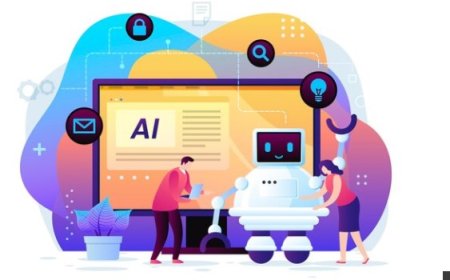AI in Marketing: Personalization and Customer Insights
Discover how artificial intelligence can revolutionize your marketing strategy and boost customer engagement.

In today's fast-paced digital landscape, artificial intelligence (AI) is reshaping the marketing industry, enabling businesses to forge deeper connections with their customers. By harnessing AI's potential, marketers can tap into data-driven insights to deliver highly personalized experiences, predict customer needs, and craft more impactful marketing campaigns.
Personalization: Crafting Tailored Experiences
In today's fiercely competitive business landscape, personalization stands as a pivotal strategy that sets brands apart. Gone are the days of one-size-fits-all marketing; customers now demand tailored experiences. This shift in consumer expectations has elevated personalization to a paramount position within marketing strategies.
Artificial Intelligence (AI) plays a pivotal role in delivering these personalized experiences. By analyzing vast troves of customer data, including browsing history, purchase behavior, and demographic information, AI empowers businesses to understand their customers at an unprecedented depth. This understanding becomes the foundation upon which highly tailored experiences are constructed.
The benefits of personalization extend to both businesses and customers. For businesses, it translates into increased customer satisfaction, greater customer loyalty, and improved conversion rates. When customers receive content, product recommendations, and offers that resonate with their individual preferences, it fosters a stronger emotional connection to the brand. Ultimately, the era of AI-driven personalization is ushering in an era where businesses can provide not just products or services, but unique and meaningful experiences.
Predictive Analytics: Anticipating Customer Desires
Predictive analytics, fueled by AI, plays a pivotal role in reshaping marketing strategies. It involves using advanced algorithms to analyze vast amounts of historical data to uncover patterns, trends, and potential future outcomes. By leveraging this technology, businesses gain the ability to anticipate customer desires and behaviors with unprecedented accuracy.
AI algorithms behind predictive analytics are designed to scrutinize historical data points, such as past purchase behavior, website interactions, and customer preferences. These algorithms sift through this data to identify correlations and hidden insights that might not be apparent through conventional analysis. The algorithms continuously learn and adapt, becoming more precise over time.
Real-world examples of predictive analytics in marketing abound. E-commerce platforms, for instance, employ predictive models to recommend products to individual customers based on their past purchases and browsing history. Airlines use predictive analytics to adjust ticket prices dynamically, optimizing revenue. Moreover, email marketing campaigns often employ predictive analytics to forecast open and click-through rates, enabling marketers to tailor content for maximum impact. These examples underscore the transformative power of predictive analytics in driving marketing strategies.
Customer Segmentation: Laser-Focused Targeting
Customer segmentation is a cornerstone of effective marketing, and AI is revolutionizing how businesses approach this crucial aspect of their strategy. The value of precise customer segmentation cannot be overstated. It allows companies to break their customer base into distinct groups based on shared characteristics, behaviors, and preferences.
AI plays a pivotal role in streamlining customer segmentation. By analyzing vast datasets quickly and efficiently, AI algorithms identify patterns and nuances that would be challenging for humans to uncover manually. This level of automation not only saves time but also ensures that segmentation is based on data-driven insights rather than assumptions.
The benefits of this approach are numerous. With AI-driven customer segmentation, marketers can create highly targeted campaigns tailored to each audience segment's unique needs and preferences. This precision minimizes marketing waste, as resources are directed toward the most receptive audience, ultimately leading to higher conversion rates and a more efficient allocation of marketing budgets.
Chatbots and Virtual Assistants: Elevating Customer Interactions
AI-powered chatbots and virtual assistants have ushered in a new era of customer interactions. Their impact on enhancing user experiences is profound. These intelligent bots provide immediate and accurate responses, ensuring real-time customer support and information retrieval. This not only improves customer satisfaction but also significantly reduces response times, leading to higher levels of engagement. Additionally, businesses benefit from the cost-effectiveness and efficiency of these AI-driven solutions, making them indispensable tools in modern customer service strategies. For instance, leading companies in e-commerce and banking have successfully integrated chatbots to handle routine queries, resulting in streamlined and seamless interactions for their customers.
Sentiment Analysis: Deciphering Customer Emotions
Sentiment analysis, powered by artificial intelligence, is the process of using algorithms to assess and understand the emotions and opinions expressed in customer feedback, reviews, and social media interactions. It works by analyzing the text for positive, negative, or neutral sentiments, providing valuable insights into how customers feel about a brand, product, or service.
Understanding customer emotions is paramount in today's competitive market. It enables businesses to gauge customer satisfaction levels, identify areas for improvement, and tailor their strategies to meet customer expectations. By deciphering sentiments, companies can respond effectively to both positive and negative feedback, ultimately fostering stronger customer relationships.
In practical terms, sentiment analysis holds a myriad of real-life applications in marketing. It can be employed to monitor social media sentiment surrounding a product launch, helping brands gauge public reception. Additionally, it aids in assessing customer reviews, allowing businesses to identify common pain points or areas of praise. By incorporating sentiment analysis into their strategies, marketers can refine their messaging, tailor promotional efforts, and address customer concerns with precision and agility.
Real-Time Personalization: Adapting on the Fly
Real-time personalization is a dynamic approach to marketing that leverages AI to adapt and tailor content on the fly based on customer behavior, preferences, and interactions. This concept revolutionizes how businesses engage with their audience by delivering precisely what the customer needs, exactly when they need it.
In practice, real-time personalization can be seen in various scenarios. For instance, when a customer visits an e-commerce website, AI algorithms can analyze their browsing history, previous purchases, and real-time clickstream data to recommend products that are most relevant to their current interests. This immediate and customized content not only captures the customer's attention but also significantly enhances their overall experience.
Through real-time personalization, businesses can foster deeper connections with their customers, drive higher engagement, and increase conversion rates, ultimately setting a new standard for customer-centric marketing.
Challenges and Considerations
While AI offers remarkable benefits to marketing, marketers must confront several challenges to maximize its potential:
-
Data Privacy and Ethics: AI-driven personalization heavily relies on customer data. Marketers must prioritize data privacy, ensuring that customer information is protected and used ethically, in compliance with relevant regulations.
-
Data Quality and Integration: For AI to deliver accurate insights, data must be of high quality and well-integrated from various sources. Marketers should invest in data management and integration solutions to ensure AI algorithms are fed with reliable data.
-
Overcoming Bias: AI algorithms may inadvertently inherit biases present in historical data, leading to skewed insights and personalized recommendations. Marketers must vigilantly monitor and audit AI algorithms to avoid perpetuating bias.
-
Balancing Automation and Human Touch: While AI enhances efficiency, it should be balanced with human expertise and empathy. Building customer relationships requires a human touch that can't be entirely replaced by AI.
The Future of AI in Marketing
As AI technology continues to advance, the future of marketing holds exciting possibilities:
-
Hyper-Personalization: AI will refine personalized marketing by analyzing a broader range of customer data, including real-time interactions, wearables, and Internet of Things (IoT) devices, leading to hyper-personalized customer experiences.
-
Augmented Reality (AR) and Virtual Reality (VR): AI-powered AR and VR experiences will revolutionize product demonstrations, allowing customers to virtually interact with products and making shopping more immersive.
-
Voice and Visual Search: With advancements in natural language processing and computer vision, AI will enhance voice and visual search capabilities, providing more intuitive and seamless search experiences.
-
AI-Powered Content Creation: AI-generated content, such as product descriptions and social media posts, will become more prevalent, allowing marketers to produce personalized and relevant content at scale.
-
Autonomous Marketing Campaigns: AI-driven marketing campaigns will become more autonomous, with algorithms analyzing campaign performance and making real-time adjustments to optimize outcomes.
AI is reshaping the marketing landscape by unleashing the power of personalization and customer insights. By harnessing AI's capabilities, businesses can create stronger connections with their customers, anticipate their needs, and deliver marketing campaigns that truly resonate, setting the stage for sustained success in the digital age.




























































